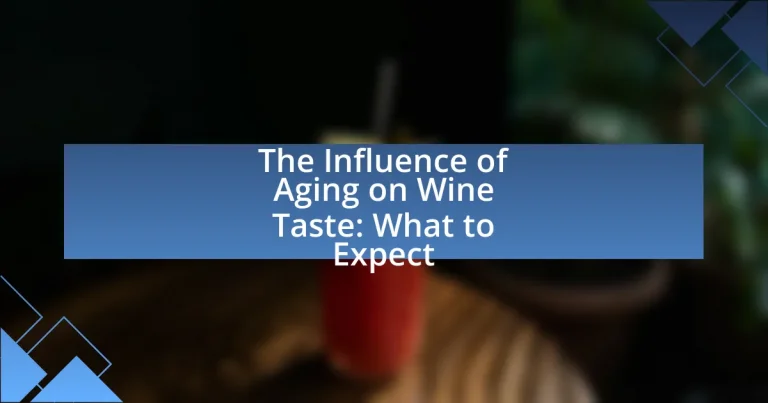The article examines the influence of aging on wine taste, highlighting how the aging process enhances complexity and alters flavor profiles. It discusses the chemical changes that occur during aging, including the softening of tannins and the development of secondary and tertiary flavors, which contribute to a smoother mouthfeel and a more balanced taste. The article also outlines the factors that affect aging, such as temperature, humidity, and storage conditions, and identifies which types of wines are best suited for aging. Additionally, it provides insights into the sensory changes in aroma and flavor that occur in aged wines, as well as best practices for serving and pairing them with food.

What is the Influence of Aging on Wine Taste?
Aging significantly influences wine taste by enhancing complexity and altering flavor profiles. As wine ages, chemical reactions occur, leading to the development of secondary and tertiary flavors, such as earthy, nutty, or floral notes, which are not present in younger wines. Additionally, tannins soften over time, resulting in a smoother mouthfeel and a more balanced taste. Research indicates that wines with higher acidity and tannin levels, such as Cabernet Sauvignon and Barolo, tend to age better, allowing for a more pronounced evolution in flavor. This transformation is supported by studies showing that aged wines often receive higher ratings from sommeliers and wine critics due to their refined characteristics.
How does aging affect the flavor profile of wine?
Aging significantly alters the flavor profile of wine by enhancing complexity and integrating flavors. As wine ages, chemical reactions occur, leading to the development of secondary and tertiary flavors such as dried fruit, nuts, and earthy notes, while primary fruit flavors may diminish. Research indicates that the aging process allows for the oxidation of phenolic compounds, which softens tannins and contributes to a smoother mouthfeel. Additionally, the interaction between wine and its container, particularly oak barrels, introduces flavors like vanilla, spice, and toast, further enriching the wine’s profile. Studies have shown that wines aged for specific durations often exhibit distinct flavor characteristics, with red wines typically benefiting from longer aging compared to whites.
What chemical changes occur in wine during aging?
During aging, wine undergoes several chemical changes that significantly affect its flavor, aroma, and overall quality. Key changes include the oxidation of phenolic compounds, which leads to the development of complex flavors and aromas, as well as the polymerization of tannins, resulting in a smoother mouthfeel. Additionally, the breakdown of acids and the formation of esters contribute to the wine’s bouquet, enhancing its aromatic profile. These transformations are facilitated by the interaction of wine with oxygen, which occurs through the porous nature of corks or during barrel aging. Studies have shown that these chemical reactions can improve the wine’s stability and aging potential, making it more enjoyable over time.
How do tannins evolve as wine ages?
Tannins evolve in wine as it ages by undergoing polymerization and oxidation, which leads to a decrease in astringency and bitterness while enhancing complexity and smoothness. During aging, tannins interact with other compounds in the wine, forming larger molecules that soften the mouthfeel. This process is influenced by factors such as the type of grape, winemaking techniques, and storage conditions. Research indicates that wines with higher tannin content, like Cabernet Sauvignon, can benefit significantly from aging, resulting in a more balanced and harmonious flavor profile over time.
Why is aging considered important in wine production?
Aging is considered important in wine production because it significantly enhances the flavor, aroma, and overall complexity of the wine. During the aging process, chemical reactions occur that develop desirable characteristics, such as tannin softening and the integration of flavors. For example, red wines often benefit from aging as it allows for the maturation of tannins, which can lead to a smoother mouthfeel and a more balanced taste profile. Additionally, aging can introduce secondary and tertiary aromas, such as vanilla, spice, and earthy notes, which are often derived from interactions with oak barrels. Studies have shown that wines aged for specific periods can achieve a higher quality rating, indicating that aging is a critical factor in determining the final product’s excellence.
What role does aging play in developing complexity in wine?
Aging plays a crucial role in developing complexity in wine by allowing chemical reactions to occur that enhance flavor, aroma, and texture. During aging, compounds such as tannins and acids soften, while esters and other aromatic compounds develop, leading to a more nuanced profile. Research indicates that wines aged in oak barrels can absorb compounds like vanillin and lactones, contributing to additional layers of flavor. Furthermore, the process of oxidation during aging can create complex aromas, such as dried fruit and nutty notes, which are often absent in younger wines. This transformation is supported by studies showing that wines aged for extended periods exhibit greater complexity compared to their younger counterparts, as evidenced by sensory evaluations conducted by wine experts.
How does the aging process differ between red and white wines?
The aging process differs significantly between red and white wines primarily due to their composition and tannin levels. Red wines, which contain higher tannins from grape skins, seeds, and stems, typically benefit from longer aging periods, allowing the tannins to soften and complex flavors to develop. In contrast, white wines generally have lower tannin levels and are often consumed younger, as they can lose freshness and acidity if aged too long. For example, many red wines can age for several years to decades, while most white wines are best enjoyed within a few years of bottling. This difference in aging is supported by the fact that red wines often undergo malolactic fermentation, which enhances their complexity over time, whereas white wines usually do not undergo this process, leading to a different aging trajectory.

What Factors Influence the Aging Process of Wine?
The aging process of wine is influenced by several key factors, including temperature, humidity, light exposure, oxygen levels, and the type of container used for aging. Temperature affects the rate of chemical reactions in wine; optimal aging occurs between 50°F and 55°F. Humidity levels between 50% and 80% help maintain cork integrity, preventing oxidation. Light exposure can degrade wine quality, so dark storage is preferred. Oxygen levels are crucial; controlled exposure can enhance aging, while excessive oxygen leads to spoilage. Finally, the type of container, such as oak barrels versus stainless steel, impacts flavor development and tannin integration. These factors collectively determine the wine’s evolution in taste and aroma over time.
How do storage conditions impact wine aging?
Storage conditions significantly impact wine aging by influencing the chemical reactions that occur within the bottle. Factors such as temperature, humidity, light exposure, and vibration play crucial roles in determining the quality and longevity of wine. For instance, optimal storage temperature ranges between 45°F to 65°F (7°C to 18°C), as temperatures outside this range can accelerate aging or spoilage. Humidity levels should ideally be around 70% to prevent corks from drying out, which can lead to oxidation. Additionally, exposure to UV light can degrade wine, while vibrations can disturb sediment and affect flavor development. Studies have shown that wines stored under ideal conditions can age gracefully, enhancing their complexity and taste, while poor storage can lead to premature aging or spoilage.
What temperature is ideal for aging wine?
The ideal temperature for aging wine is between 50°F and 55°F (10°C to 13°C). This temperature range allows for slow and steady maturation, which is essential for developing complex flavors and aromas in the wine. Studies indicate that temperatures above 70°F (21°C) can accelerate aging and potentially spoil the wine, while temperatures below 45°F (7°C) can hinder the aging process. Therefore, maintaining a consistent environment within the specified range is crucial for optimal wine aging.
How does humidity affect the aging of wine?
Humidity significantly affects the aging of wine by influencing the integrity of the cork and the evaporation rate of the wine. High humidity levels help maintain the cork’s elasticity, preventing it from drying out and allowing oxygen to enter the bottle, which can spoil the wine. Conversely, low humidity can lead to cork shrinkage, increasing the risk of oxidation. Research indicates that optimal humidity levels for wine storage range between 50% and 80%, as this range effectively preserves the cork and minimizes evaporation, ensuring the wine ages gracefully.
What types of wine are best suited for aging?
Red wines, particularly those with high tannin levels and acidity, are best suited for aging. Varieties such as Cabernet Sauvignon, Bordeaux blends, and Barolo are known for their aging potential due to their robust structure and complex flavor profiles that develop over time. For instance, Cabernet Sauvignon can age for decades, evolving from fruity to more nuanced flavors like leather and tobacco. Additionally, white wines like Riesling and certain Chardonnays can also benefit from aging, as they develop richer textures and flavors with time. The aging process allows these wines to soften and integrate their flavors, enhancing overall complexity and depth.
Which varietals improve with age?
Red varietals such as Cabernet Sauvignon, Merlot, and Syrah improve with age. These wines develop complex flavors and aromas over time due to the gradual oxidation and polymerization of tannins and phenolic compounds. For instance, Cabernet Sauvignon can age for 10 to 30 years, enhancing its structure and depth, while Merlot typically reaches its peak between 5 to 15 years. Studies have shown that aged wines often exhibit greater balance and a more nuanced profile, making them highly sought after by collectors and connoisseurs.
How does the wine’s initial quality influence its aging potential?
The wine’s initial quality significantly influences its aging potential by determining how well it can develop complex flavors and aromas over time. High-quality wines typically possess balanced acidity, tannins, and fruit concentration, which are essential for a successful aging process. For instance, wines with higher acidity and tannin levels, such as Barolo or Bordeaux, are known to age better because these components act as natural preservatives, allowing the wine to evolve and mature gracefully. Studies have shown that wines rated 90 points or higher by critics often exhibit superior aging potential, as they are crafted from optimal grape varieties and undergo meticulous winemaking processes.

What Can Wine Enthusiasts Expect from Aged Wine?
Wine enthusiasts can expect a complex flavor profile and enhanced aromas from aged wine. As wine ages, chemical reactions occur that develop deeper flavors, such as earthy, nutty, or fruity notes, which are often absent in younger wines. Additionally, tannins soften over time, resulting in a smoother mouthfeel. Research indicates that wines like Bordeaux and Barolo can improve significantly with age, often reaching their peak after 10 to 20 years, depending on the varietal and storage conditions. This maturation process is supported by studies showing that aging can lead to increased complexity and balance in wine, making it more enjoyable for connoisseurs.
How can one identify the characteristics of aged wine?
One can identify the characteristics of aged wine by examining its color, aroma, flavor profile, and texture. Aged wines typically exhibit a deeper, more muted color compared to their younger counterparts, often transitioning from vibrant reds to brick or tawny hues. The aroma of aged wine often develops complex notes such as leather, tobacco, or dried fruit, which are less pronounced in younger wines. In terms of flavor, aged wines tend to have a smoother, more integrated taste with softer tannins and a greater depth of flavor, often showcasing earthy or savory elements. Additionally, the texture of aged wine is usually silkier, reflecting the maturation process. These characteristics are well-documented in wine literature, indicating that aging can significantly alter the sensory profile of wine, enhancing its complexity and overall enjoyment.
What sensory changes can be expected in aged wine?
Aged wine typically exhibits sensory changes such as enhanced complexity, softer tannins, and altered aromas and flavors. As wine ages, its tannins become less astringent, leading to a smoother mouthfeel. Aromatically, aged wines often develop tertiary notes like leather, tobacco, and dried fruits, which contrast with the primary fruit characteristics present in younger wines. Research indicates that these changes occur due to chemical reactions, including oxidation and polymerization, which evolve the wine’s profile over time. For instance, a study published in the Journal of Agricultural and Food Chemistry highlights how aging can lead to the formation of new aromatic compounds, enriching the sensory experience of the wine.
How does the aroma of aged wine differ from young wine?
The aroma of aged wine differs from young wine primarily in complexity and depth. Aged wines typically exhibit more nuanced and layered aromas, including notes of dried fruit, leather, tobacco, and earthy undertones, which develop through the oxidation process and interaction with oak barrels. In contrast, young wines often present fresher, fruit-forward aromas such as berries, citrus, and floral notes, reflecting their youthful vibrancy. This distinction arises because aging allows chemical compounds to evolve, leading to the formation of new aromatic compounds while diminishing the intensity of primary fruit aromas.
What are the best practices for enjoying aged wine?
To enjoy aged wine, it is essential to serve it at the appropriate temperature, typically between 60-65°F (15-18°C) for red wines and 50-55°F (10-13°C) for white wines. This temperature range enhances the wine’s complex flavors and aromas, allowing the nuances developed during aging to be fully appreciated. Additionally, using proper glassware, such as a wide-bowled glass for reds, helps in aerating the wine, which can further enhance its taste.
Decanting aged wine is also recommended, as it allows for the separation of sediment and the introduction of oxygen, which can improve the wine’s bouquet. It is advisable to taste the wine slowly, taking note of its evolving flavors, as aged wines can change significantly over time. Lastly, pairing aged wine with complementary foods, such as rich meats or aged cheeses, can elevate the overall tasting experience, as these pairings can enhance the wine’s characteristics.
How should aged wine be served and paired with food?
Aged wine should be served at a slightly warmer temperature than young wines, typically between 60°F to 65°F (15°C to 18°C), to enhance its complex aromas and flavors. This temperature range allows the wine’s nuances to be more pronounced, making it more enjoyable. When pairing aged wine with food, it is essential to consider the wine’s characteristics; for example, aged red wines often pair well with rich dishes like beef, lamb, or game, while aged white wines complement seafood, poultry, and creamy sauces. The complexity and depth of aged wines can elevate the dining experience, as they often have developed secondary and tertiary flavors that harmonize with various culinary elements.
What tips can enhance the tasting experience of aged wine?
To enhance the tasting experience of aged wine, it is essential to serve it at the optimal temperature, typically between 60-65°F (15-18°C), as this range allows the complex flavors to emerge fully. Additionally, decanting the wine before tasting can aerate it, helping to release aromas and soften tannins, which is particularly beneficial for older wines that may have sediment. Using appropriate glassware, such as a tulip-shaped glass, can concentrate the aromas, further enriching the tasting experience. Finally, taking time to savor the wine, allowing for multiple sips to appreciate its evolving profile, is crucial, as aged wines often reveal different characteristics over time.


